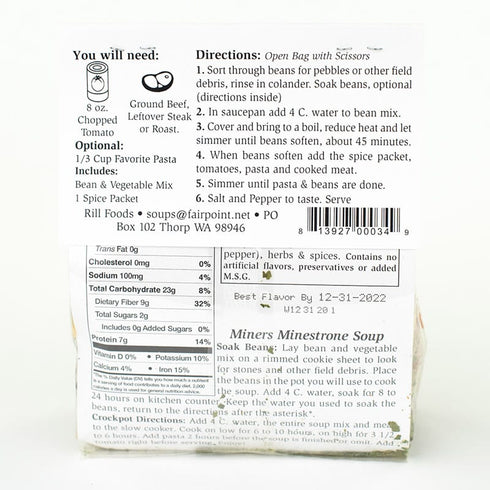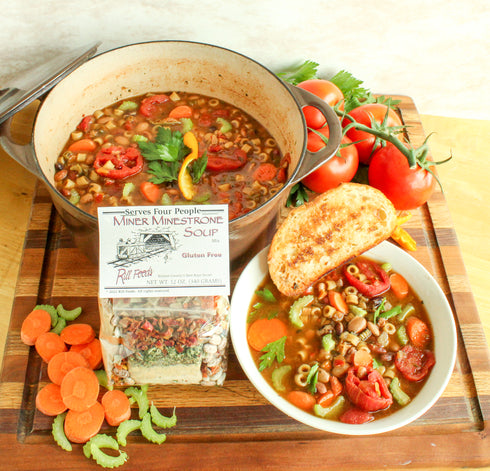Cooking Time
90 minutes
(with pre-soaked beans)
Serving Size
10 cups
Kettle Size
4 quarts
Ingredients
Mixed beans, split peas, barley, dehydrated vegetables (carrots, celery, potatoes, bell peppers, leeks, cabbage), black pepper, herbs and spices
Available in small and large packages
Small: 4-5 1 cup servings
Large: 8-10 1 cup servings
Nutritional Facts for small package: Serv. Size 1 cup, Servings 5 Amount Per Serving: Calories 120, Fat Cal 0, Total Fat 0g (0% DV), Sat Fat 0g (0% DV), Cholest.0mg (0% DV), Sodium 320mg (13% DV), Total Carb. 22g (7% DV), Fiber 6g (24% DV), Sugars 3g, Protein 7g, Vitamin A (8% DV), Vitamin C (15% DV), Calcium (4% DV), Iron (15% DV). Percent Daily Values (DV) are based on a 2000 calorie diet.
 Product of Washington State
Product of Washington State

Rill's Specialty Soups are a Product of Washington State.
Great Ideas for Dressing up your Miners Minestrone Soup
| Add |
Your favorite vegetables Reduce sodium by limited the amount of beef base (brown packet) used. |
| Vegetarian | Leave out the brown pack of beef base, add 15-oz. vegetable broth and reduce water in recipe by two cups. If desired, add meat substitute. |
Tidbits of Mining History
Mining has been a large part of U.S. history. Our lands are rich with natural resources and there are many stories of mining and small boomtowns. People migrated all across the country in hopes of riches and steady employment.
In the late 1800s the industrial movement of the United States gained momentum. The need for coal increased rapidly, and mining started in many states. Most of the mines were in remote areas and U.S. currency was difficult to keep in hand. Companies began to issue script tokens as an advance payment for wages earned. These tokens could be spent at the company store for food, clothing and supplies.
The work was exhausting, men worked underground for 11 to 12 hours a day, when the market for coal dropped, they had worked as little as two days a week. Wages were either based on the amount of coal the miner could dig or on an hourly wage of about .20 cents. Before wages were paid the company store deducted rent, utilities, health cares and charges owing the store. Men who were unable to continue heavy work stood at the screening tables handpicking rock from the coal.
In the State Of Washington, the Leary Coal Company opened a seam at Ravensdale, in 1890 (this is Northwest of Black Diamond) it soon began to produce so well that it attracted the NW Improvement Company, the coal mining arm of the Northern Pacific railroad. They bought the land and brought in experienced Italian, Polish, and Lithuanian miners from the east coast. In 1915 an explosion killed 31 miners. This combined with a declining demand they closed the mine and moved many of the houses to Roslyn where they also were operating mines.
Roslyn sits atop a coalfield that stretches for 7 miles. In 1884, Nez Jensen, A homesteader dug coal with a pick and shovel and sold it to the blacksmiths in Ellensburg area. Two years later the Northern Pacific Railroad examined the deposits and with in weeks had miners digging Coal. By 1898, a decade after opening the Roslyn mines they accounted for half the coal production in the state. At its peak in the 1920s two million tons of coal were mined annually. The miners in that area made more in 2 days working the Roslyn mines than could be earned in 2 weeks work as a garment worker in New York City.
Idaho State's first industry was mining, and still is today 130 years after the discovery of gold, in 1860, remains as an important part of the states economy. The Coeur d’ Alene mining district is proven to be the richest silver mining district in the world. In 1985 the mines produced their one-billionth ounce of silver and also vast amounts of lead, zinc, and copper. Other records in the Silver Valley include “the Morning Star” one of the deepest mines in America. Bunker Hill ranks as America’s largest underground mine: And the Sunshine Mine America’s richest silver mine, producing over 300 million ounces of silver more than the entire output of Nevada’s famous Comstock Lode.
Montana's Giltedge Mine was the first place in the United States to use cyanide-leeching process in gold mining. This began in 1893 just when the USA was in the depths of a serve economic depression. It was carefully watched by the national financial and international mining world. They felt that if Giltedge produced successfully investors could be easily persuaded to invest in cyanide plants in other mining areas reducing the depression.
Minestrone History
Minestrone soup has no set recipe and the word minestrone has become a synonym for hodgepodge. Minestrone is one of the cornerstones of Italian cuisine and may be more widely dispersed and eaten throughout Italy than pasta. Common ingredients include beans, onions, celery, carrots, and tomatoes. Add any vegetable that is in season and make this soup distinctly yours.
Legume Hints & Nutrition
The USDA recommends that adults eat three cups of beans or legumes per week for the maximum health benefit. Legumes are naturally low in total fat, contain no saturated fat or cholesterol, and are an excellent source of protein, calcium, iron, folic acid, and potassium. Beans should always be sorted, cleaned and washed to remove any small rocks, etc.
Free Shipping -
All orders of $50 or more qualify for free shipping excluding Traxxas RC vehicles. RC vehicles ship for $9.99 - $12.99 each (in-state vs. out of state).
Free Local Delivery -
Within Kittitas County (M-F)
Returns & 100% Money Back Guarantee -
If within the first 15 days after receiving your order you would like to return your item(s) for any reason, call 509-925-9851 or email Order@Jerrols.com and we will email you a return label to print and use to ship back to us via USPS.








